Artistic design candidates for the Civil Air Patrol Congressional Gold Medal have been unveiled by the United States Mint and reviewed by the Commission of Fine Arts (CFA) and Citizens Coinage Advisory Committee (CCAC).
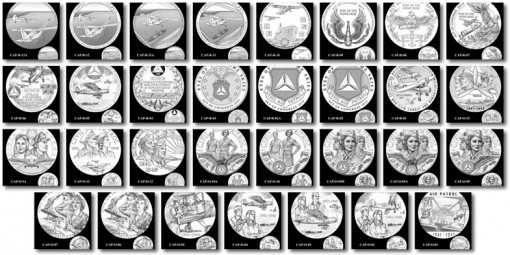
Public Law No: 113-108 authorizes a Congressional Gold Medal to honor collectively the World War II members of the Civil Air Patrol (CAP) in recognition of their military service and exemplary record. The law also calls for duplicates in bronze for sale to the public.
In total, 31 design candidates were created. They include 16 for the obverse or heads side and 15 for the reverse or tails side. These designs must be narrowed down to one obverse and one reverse.
The CFA made their recommendations on Sept. 18, preferring obverse design CAP-O-15 and reverse design CAP-R-04. Here are images of the CFA selections:
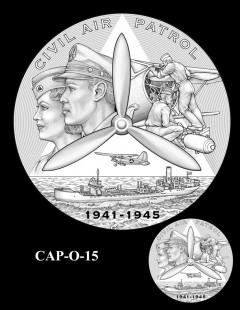 |
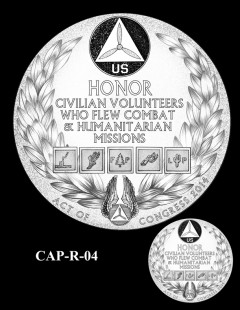 |
The CCAC offered up their suggestions on Sept. 23, selecting obverse design CAP-O-14 and reverse design CAP-R-03. They added a motion to remove Act of Congress from obverse and leave the same inscriptions on the reverse. Here are images of the CCAC selections:
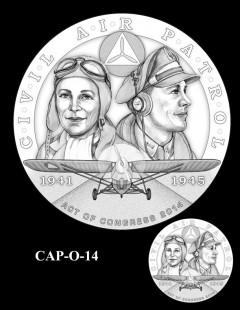 |
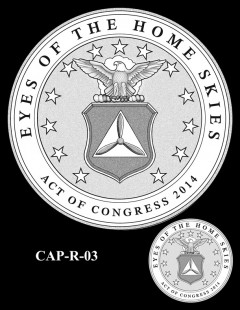 |
After consulting with various parties, reviewing suggestions from the CCAC and CFA, and receiving recommendations from the U.S. Mint, the Treasury Secretary will make the final design selections.
All obverse and reverse candidate designs are shown below. Also included are brief narratives of each as provided by the United States Mint.
Obverse CAP Congressional Gold Medal Design Candidates
While not required by law, artists were given Civil Air Patrol and 1941-1945 as suggested inscriptions. These are included on all obverse designs.
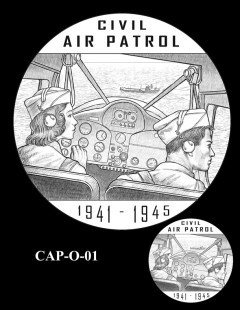
CAP-O-01 – Two Civil Air Patrol (CAP) pilots scan the coastal waters from the cockpit of a Fairchild 24. They are banking to the right to get a clearer view of the ocean.
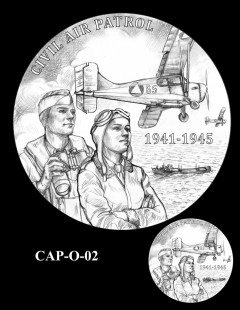 |
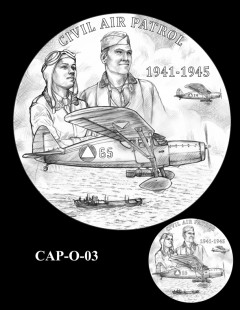 |
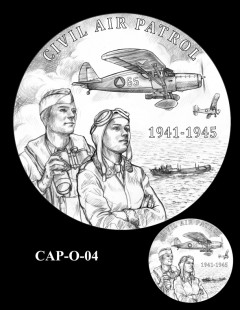 |
|
CAP-O-02, CAP-O-03, and CAP-O-04 – Two CAP volunteers watch the skies. In the background, a tanker is escorted by CAP planes overhead.
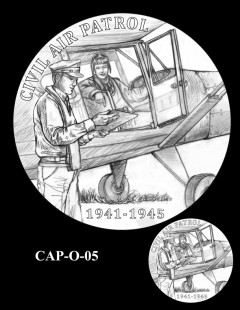
CAP-O-05 – Two CAP pilots prepare for a rescue mission.
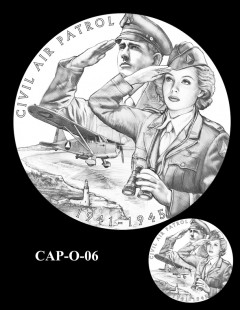 |
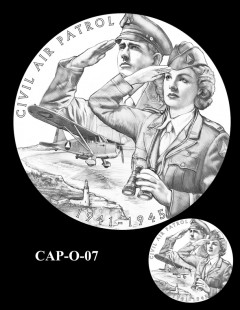 |
CAP-O-06 and CAP-O-07 – Two CAP crew members salute and vigilantly observe the skies and coastline. In the foreground, an armed Stinson 10 scours the coastal water for enemy vessels.
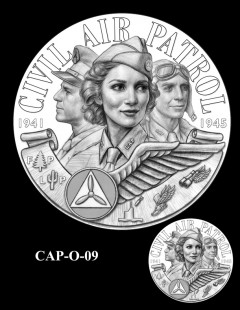 |
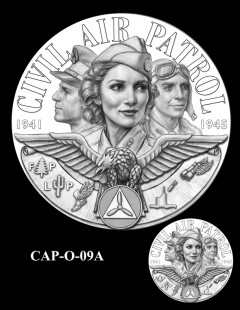 |
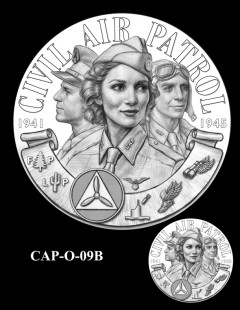 |
|
CAP-O-09, CAP O-09A, and CAP-O-09B – These designs depict three courageous pilots of the CAP during WWII. The five CAP patches are depicted along the bottom of the design, along with the CAP roundel. Design 09 features the CAP single wing emblem, while design 09A features an eagle.
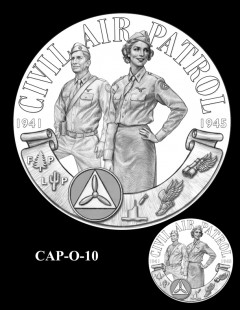 |
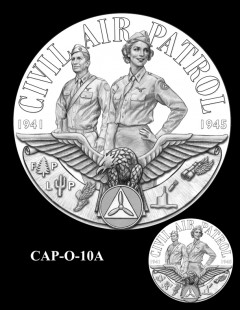 |
CAP-O-10 and CAP-O-10A – These designs depict two CAP pilots. The five patrol patches are depicted along the bottom of the design. Design 10A features an eagle atop the roundel.
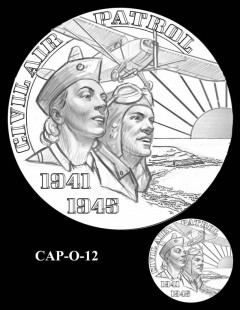
CAP-O-12 – Two CAP pilots survey the landscape with a plane surveying the coastline in the background.
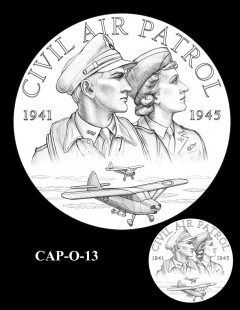
CAP-O-13 – Two CAP pilots are seen in profile with a pair of planes flying below.

CAP-O-14 – This design depicts two CAP pilots with the CAP roundel centered above and behind them. The figures are positioned over an armed single-engine CAP aircraft as it lifts off of the runway. The composition’s underlying structure resembles the CAP roundel.

CAP-O-15 – The CAP roundel forms the basis of this design with the propeller shape dividing the space into three equal segments representing the pilots, the support crews, and the CAP mission itself. To the left are two CAP pilots in profile. To the right, a ground support crew prepares a plane for its mission. The bottom section depicts one of the many important missions undertaken by the CAP.
Reverse CAP Congressional Gold Medal Design Candidates
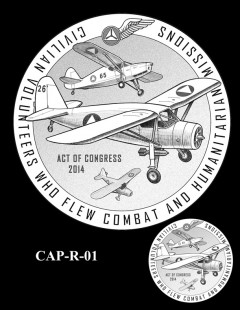
CAP-R-01 – Three CAP planes fly a coastal mission. The center aircraft is fitted with a 100-pound bomb. A CAP insignia is featured at the top of the design. Inscriptions read Civilian Volunteers Who Flew Combat and Humanitarian Missions and Act of Congress 2014.
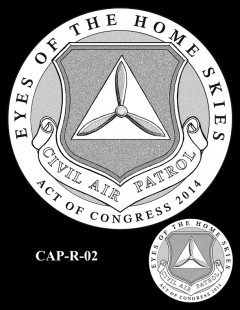 |
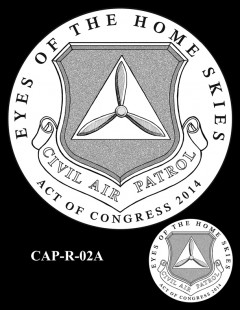 |
 |
|
CAP-R-02, CAP-R-02A, and CAP-R-03 – These designs feature variations on a CAP insignia. Inscriptions read Eyes of the Home Skies and Act of Congress 2014. Designs 2 and 2A feature the additional inscription Civil Air Patrol across the lower banner.

CAP-R-04 – A partial laurel wreath, representing honor and service, surrounds CAP insignias. Inscriptions read Honor, Civilian Volunteers Who Flew Combat & Humanitarian Missions, and Act of Congress 2014.
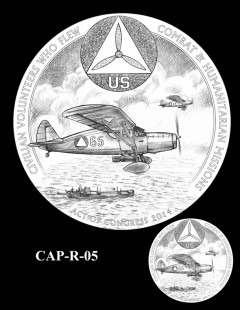
CAP-R-05 – CAP planes escort a merchant ship to shore. The CAP roundel is depicted at the top of the design. Inscriptions read Civilian Volunteers Who Flew Combat & Humanitarian Missions and Act of Congress 2014.
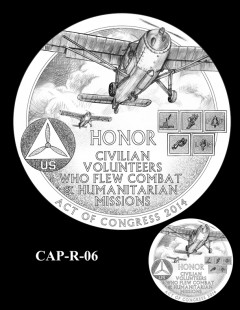
CAP-R-06 – Two CAP planes fly overhead with the CAP roundel and patrol patches below. The inscriptions read Honor, Civilian Volunteers Who Flew Combat and Humanitarian Missions, and Act of Congress 2014.
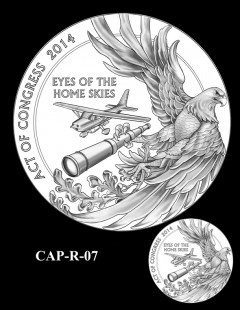
CAP-R-07 – This design depicts an eagle holding a scope, reminiscent of the CAP coastal patrol badge. The eagle clutches a branch of oak, symbolizing strength. A CAP plane flies in the background. Inscriptions read Eyes of the Home Skies and Act of Congress 2014.
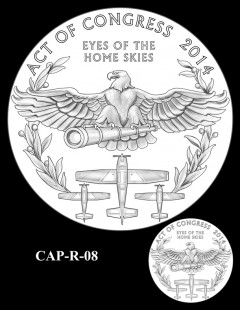
CAP-R-08 – A stylized eagle clutches a scope, reminiscent of the CAP coastal patrol badge. The design is framed by olive branches, symbolizing unity. Three planes used by the CAP are featured at the bottom of the design. The inscriptions read Eyes of the Home Skies and Act of Congress 2014.
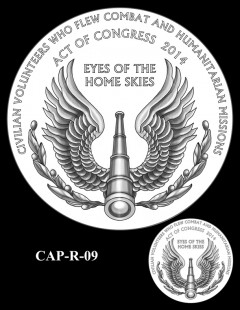
CAP-R-09 – This design depicts a stylized version of the CAP coastal patrol badge. The design is surrounded by laurel, signifying victory. The inscriptions read Eyes of the Home Skies, Civilian Volunteers Who Flew Combat and Humanitarian Missions, and Act of Congress 2014.
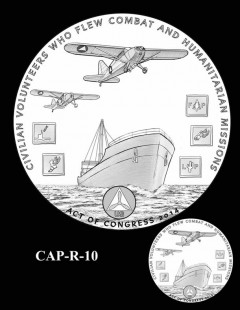
CAP-R-10 – A pair of CAP planes fly over a shipping vessel, representing one of the important missions of the CAP. The five CAP mission patches are represented on either side of the design, with the CAP insignia at the base of the design. Inscriptions read Civilian Volunteers Who Flew Combat and Humanitarian Missions, and Act of Congress 2014.
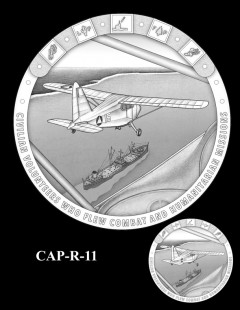 |
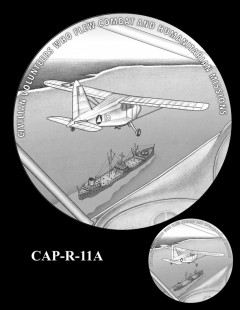 |
CAP-R-11 and CAP-R-11A – These designs portray two armed CAP light aircraft from the point of view of one of the pilots. The planes fly over an oil tanker along the Eastern seaboard. The inscription reads Civilian Volunteers Who Flew Combat and Humanitarian Missions. In design 11, the five CAP active service duty patches are positioned along the top of the rim.
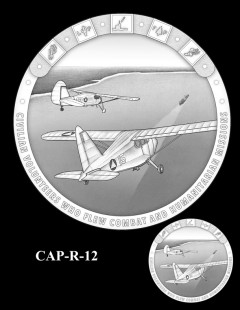 |
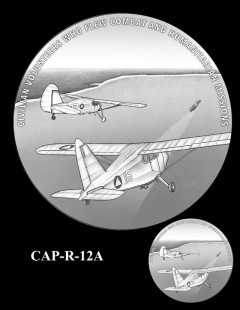 |
CAP-R-12 and CAP-R-12A –These designs are variations of reverses 11 and 11A. Two armed CAP light aircraft fly over an oil tanker along the Eastern Seaboard. The inscription reads Civilian Volunteers Who Flew Combat and Humanitarian Missions. In design 12, the five CAP active service duty patches are positioned along the top of the rim.






this run of collectors coins should start a revelation of appreciation.The sooner they are made the better.If they are man made gold I feel the protection coating helps pretty well. thank you,timothy Whitling
After looking over all the samples I agree with the CFA samples at the top of the page. Many of the others are either too busy or cluttered, while many of the others are too simple r do not show enough or other reasons. The O-14/R-04 combination is a good balance.
I agree with you George
I agree with George Minnich. The O-14R-04 is also my choice.
The coin that should not be considered is 013. The aircraft depicted is a 1947 Stinson 108 series aircraft that was not produced during WW2. Additionally, the bomb is mounted aft of the landing gear on the right side of the aircraft. The aircraft that should be depicted is, the Stinson L9B from the left side displaying the aft of the left main gear bomb mount location. As a matter of technical accuracy the bomb was mounted in that location due to a physical hard point which accommodated the third seat that was removed and was an optimum location for… Read more »
O-14/R-04 is also my choice.
Well, the CFA samples were O-15/R-04 but I agree with the O-14/R-04 choice.
My favorite combination would be O-06 or O-07 (the only difference I can see is the face of the woman)/R-04. The second best reverse would be R-09.
As a wwii cap vet I like O-15 and R-14 .O-15 also represents the ground support teams.
I’m a former Civil Air patrol cadet and senior officer of the 1980’s I think all former members from WW2 up to today all deserve a medal like this. I didn’t get to go to the service because of me being to light and disqualified from military service. I didn’t want to sit by and do nothing either so my Airforce recuiter said C.A.P. will take you and they did. I gave four years of volunteer service